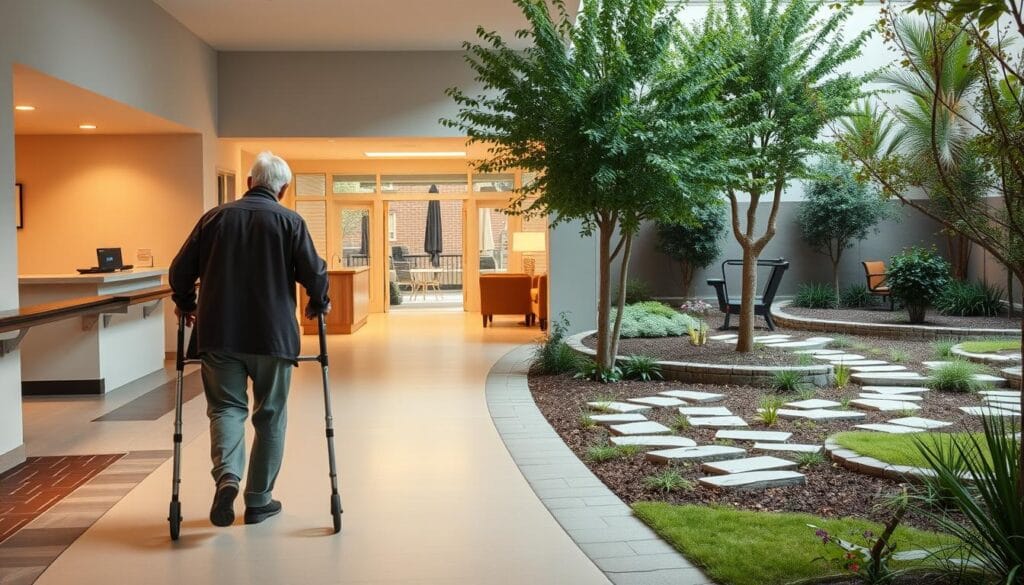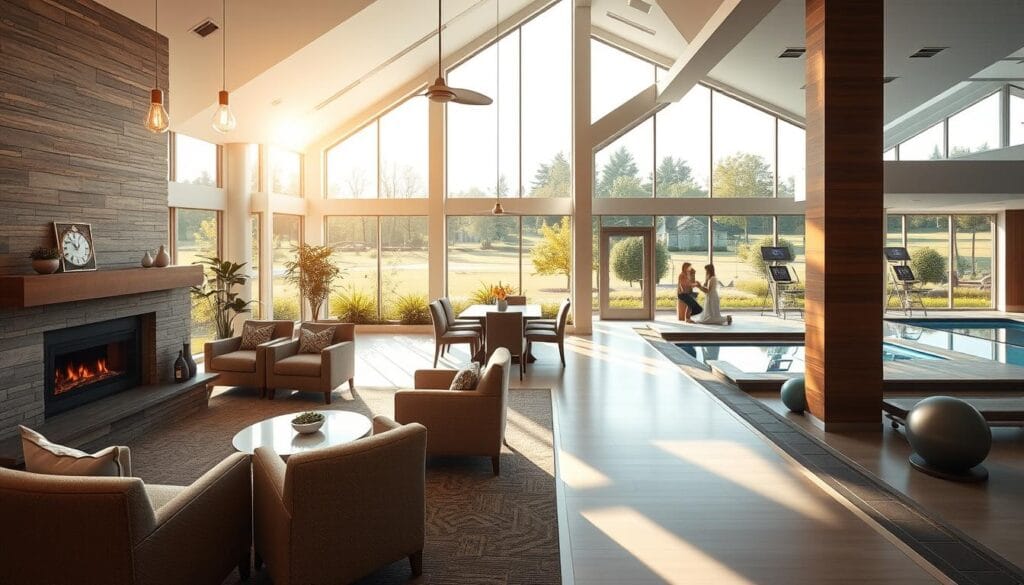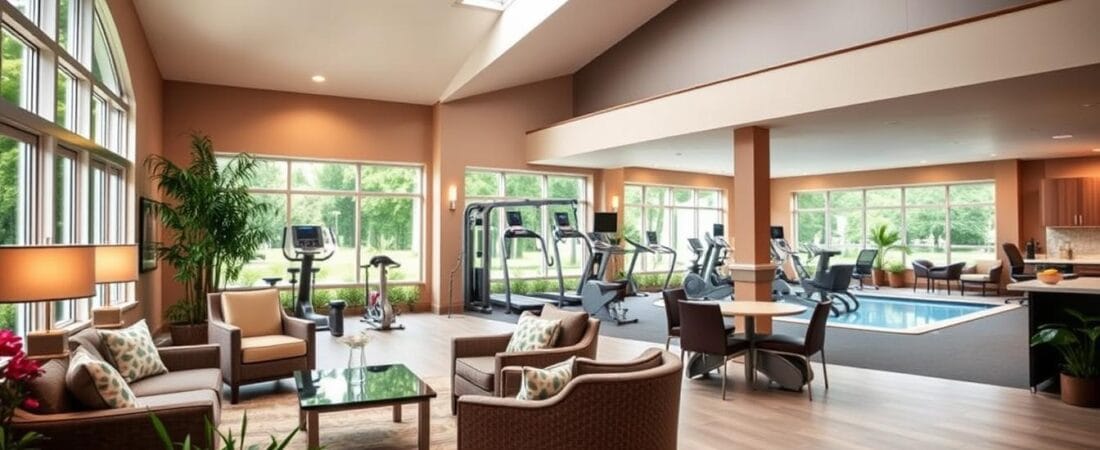Surprising fact: more than 16% of Americans are 65 or older today, and that share is set to rise to about 21.6% by 2040—shaping demand for better places to call home.
This short guide explains what older adults value most when comparing any retirement community. We focus on home-like comfort, safety features, daily services, and social life so readers can judge real differences fast.
Modern senior living now blends inviting residences, flexible floor plans, and spaces designed to support privacy and connection. Expect options that include independent units, assisted support, and memory care, plus chef-prepared dining, wellness centers, and convenient transport.
Safety and accessibility—widened doors, ramps, grab bars, and zero-threshold showers—are standard at quality sites. This introduction primes you for a clear, list-style look at the amenities, services, and choices that make day-to-day life easier and more fulfilling.
For planning tips that pair with choosing the right place, see practical guidance for remote workers and life transitions at retirement planning for remote workers.
Key Takeaways
- Population growth means more demand for thoughtful senior living design and services.
- Comfort, safety, and social spaces rank high when people compare options.
- Look for on-site dining, wellness, transport, and tech support to ease daily life.
- Choose places offering independent, assisted, and memory care to match changing needs.
- Accessibility features and maintenance-free living boost confidence and freedom.
Understanding what seniors want in retirement communities today

Today’s choices range from luxury campuses to modest apartments, and each option serves a distinct set of needs and budgets.
Independent living often removes home maintenance, adds secure entry, scheduled transport, tech support, and wellness centers so residents gain more time for hobbies and friends.
Assisted models layer personalized care for daily tasks while preserving dignity. Memory programs focus on safety, routines, and therapeutic activities for those with dementia.
- Dining and convenience: many sites feature chef-prepared meals, flexible dining venues, and nutrition support.
- Accessibility: elevators, ramps, widened doors, handrails, and zero-threshold showers cut fall risk and boost confidence.
- Amenities: fitness spaces, salons, theaters, libraries, and walking paths help keep life active and social.
| Model | Typical Services | Key Benefits | Good For |
|---|---|---|---|
| Independent living | Maintenance, meals, transport, security | More free time, predictable costs | Active adults seeking convenience |
| Assisted living | ADL help, medication support, care plans | Safety with independence | Those needing daily help |
| Memory support | Secure units, structured programs, therapy | Specialized safety and engagement | People with dementia or Alzheimer’s |
| Mixed campuses | All levels on one campus, shared amenities | Continuity of care and social options | Families planning for future changes |
Before touring, list needs and goals for your loved one and compare several sites. The growing 65+ population brings more options, so take time to match services to long-term goals.
Home-like comfort, belonging, and community connections

A warm apartment and friendly daily rhythms help people settle quickly. A living space that reads like a true home eases the move and supports emotional health.
Private, comfortable residences that feel personal
Many seniors prefer rooms with natural light, familiar furnishings, and layouts that match daily routines. Allowing personal items and favorite chairs helps residents feel rooted.
A private apartment that accepts family photos and small decor makes life feel less like a transition. This kind of personalization supports dignity and day-to-day calm.
Opportunities to build friendships with residents and staff
Design matters: quiet nooks, sunny lounges, and inviting dining spaces let people meet without pressure. Programs like morning coffee clubs or evening game nights create chances to make new friends.
Consistent staff who remember names and preferences help residents feel recognized. Informal chats in hallways or after meals often build bonds as strong as scheduled events.
- Look for: laughter in common areas, staff greeting people by name, and neighbors lingering after meals.
- Balance: a private retreat plus easy access to shared spaces lets each person choose how much to take part.
Health, safety, and accessibility that support independence

A safe, accessible built environment makes daily life easier and lowers injury risk.
Thoughtful design reduces falls and helps residents move with confidence. Bright, even lighting and clear sightlines make halls and rooms easier to navigate. Zero-threshold showers, non-slip floors, and well-placed grab bars cut hazards during routine tasks.
Simple mobility features improve day-to-day freedom. Widened doorways, handrails, and grab bars support walkers and wheelchairs. Elevators, ramps, and stairlifts ensure reliable access to every level and to shared amenities.
Secure, well-lit common areas and walkable paths encourage activity and social time while lowering confusion and risk. On-site clinics or regular visits from medical staff speed access to care such as physical therapy or podiatry.
- Ask about emergency response systems, room call buttons, and typical staff response times.
- Check ties to nearby hospitals and specialists for higher-level care if needed.
- Review incident-prevention protocols and staff training for after-hours assistance.
Bottom line: the right features and services make it easier for residents to keep independence and reduce reliance on outside assistance.
Trustworthy, compassionate teams that inspire confidence

Trust starts with people—teams who listen and respond make living smoother and safer for everyone. A well-staffed site turns services into steady support that residents notice every day.
Resident-centered care with patience, reliability, and respect
Resident-centered care treats personal routines and preferences as the starting point for daily life. Consistent, respectful staff build rapport and reduce anxiety.
Look for staff who show patience, clear communication, and continuity of caregivers. Ask about training, turnover rates, and how supervisors coach the team.
- Confirm whether assistance follows resident schedules rather than rigid timetables.
- Speak with current residents and family councils to learn how problems are handled.
- Check leadership, staffing levels, and links to outside providers for specialty needs.
Transparent reporting on response times and satisfaction surveys signals accountability. Compassionate teams free up time and emotional space for residents and family to focus on connection, not logistics.
Activities, social life, and ways to grow—inside and beyond the community

A lively calendar can turn free time into daily purpose and fresh connections. Clubs, fitness classes, lectures, and creative workshops give structure and help keep minds and bodies active.
Clubs, fitness, education, hobbies, and cultural outings
Book clubs, art groups, walking circles, and fitness sessions help people pursue interests and meet new friends. Many sites schedule concerts, movie nights, and shopping trips to keep life varied.
Independent living often frees time by removing chores, so residents can join classes or start long-postponed projects.
Events that help residents enjoy life and make new friends
Look for a balanced calendar: quiet hours, spiritual services, tech classes, and intergenerational events. Programs led by residents—teaching, hosting, or volunteering—keep offerings resident-driven.
| Offer | Why it matters | Signs it works |
|---|---|---|
| Fitness & wellness | Improves mobility and mood | High class attendance, visible energy |
| Clubs & hobby groups | Builds friendships and purpose | Regular meetups, shared projects |
| Off-site outings | Keeps ties to broader community | Full buses, post-trip conversations |
Before choosing a place, review monthly calendars and ask which events are most popular. Also check how staff collect feedback to align offerings with resident interests and abilities.
For practical planning on finances that support active living, consider how to maximize your Social Security benefits.
Amenities that elevate daily living: dining, wellness, and convenience

Well-planned amenities turn daily chores into chances for pleasure and connection. Thoughtful features help residents enjoy more of their day and reduce friction for errands and care.
Chef-prepared meals and flexible dining
From casual cafés to formal dining rooms, flexible venues make meals social and nourishing.
Chef-prepared meals and diverse menus accommodate dietary needs and taste preferences. Many places offer in-room dining and rotating menus so residents enjoy variety and proper nutrition.
Wellness centers, fitness classes, and outdoor paths
On-site wellness centers and group classes support balance, strength, and mood. Outdoor walking paths give safe options for daily movement and fresh air.
Programs that pair exercise with nutrition and social events help residents feel engaged and healthier over time.
Everyday conveniences that simplify living
Salon and barbershop services, a library, movie theater, and tech support make daily life easier and more enjoyable.
Services like transportation, security, maintenance, and parking remove hassles so residents enjoy outings and appointments.
“Try the dining room on a tour—taste, portion size, and service tell you more than any brochure.”
| Feature | Benefit | What to check |
|---|---|---|
| Dining options | Variety, nutrition, social meals | Sample food, menu rotation, special-diet handling |
| Wellness & fitness | Mobility, balance, mental health | Class schedules, staff credentials, outdoor access |
| Daily services | Convenience, time savings | Hours, pricing, booking ease |
Ask how amenities adapt to holidays or storms, and how resident feedback shapes features. For planning tips that link lifestyle with finances, consider how to plan with AI-powered tools.
Living options and levels of care that fit changing needs

Choose a living plan that adapts as needs change and preserves daily routines and friendships.
Independent choices: cottages, villas, and apartments
Independent living often includes cottages, villas, and apartment homes that blend privacy with easy access to services and amenities.
These residences typically include transportation, security, maintenance, tech support, parking, and wellness centers so daily life is simpler.
Personalized assistance while keeping freedom
Assisted living provides extra help with activities of daily living while preserving choice and dignity.
Staff offer medication cues, meal help, and personal assistance on a schedule that respects independence.
Memory support focused on safety and engagement
Memory care uses secure layouts, consistent routines, sensory-friendly activities, and specially trained staff to support residents with dementia.
Many campuses are life-plan models where several levels sit on one site. That setup reduces disruptive moves and keeps relationships steady.
- Compare floor plans, storage, and accessibility across independent living units.
- Ask which services are included and which are à la carte.
- Confirm licensure, staffing ratios, and care coordination between levels.
Tip: Review upgrade paths and budgeting, and explore long-term care options with a trusted resource like long-term care options.
Cost, value, and peace of mind: what seniors wants in retirement community
A side-by-side look at current household expenses and community fees often changes how people view affordability.
Start by itemizing mortgage or rent, property taxes, insurance, utilities, home maintenance, landscaping, and internet. That list creates a true apples‑to‑apples comparison against a single monthly fee.
Comparing monthly fees to home maintenance and utilities
Ask for a detailed fee schedule that separates included services from à la carte extras. Some sites bundle utilities, housekeeping, and Wi‑Fi into one predictable charge.
Dining plans, transportation, and wellness access may be bundled or tiered. For many residents, those bundled services offset outside spending for meals and fitness.
Understanding what services and amenities are included
- Itemize current home costs so you can compare true monthly totals.
- Confirm which services—meals, housekeeping, transport, and care—are included or optional.
- Factor in safety features and on‑site care access as part of the overall benefits.
“Predictable costs and on‑site support often bring real peace mind for residents and families.”
Also check whether fees change by level of care, how rate changes are communicated, and any entrance or resale rules. Transparent pricing makes long‑term planning simpler and reduces stress over surprises.
For a deeper look at cost versus comfort, see a personal view on cost and peace of mind at cost of peace of mind, or compare payout choices that affect your budget at annuity vs lump sum.
How to choose the right retirement community for your lifestyle
Start by listing location, climate, and daily rhythms that must match your loved one’s lifestyle. That simple step narrows options fast and keeps choices aligned with long-term happiness.
Location, culture, and nearby recreation that match your interests
Think beyond the building. Look for nearby parks, cultural venues, and climate that support hobbies and outings. Check drive times for family visits and local restaurants you hope to keep visiting.
Tour tips: taste the food, review activity calendars, talk to residents
Schedule visits at breakfast, lunch, and evening events to see true daily energy. Taste the food, scan activity calendars, and sit in on an event if possible.
- Ask residents how staff respond to feedback and what daily services feel like.
- Verify accessibility: elevators, widened doors, ramps, handrails, grab bars, and zero-threshold showers.
- Confirm proximity to reputable hospitals and on-campus medical staff for quick access.
- Compare costs, layouts, pet rules, guest stays, and transport options side-by-side to pick the best fit for your loved one.
“A short, focused tour often reveals more than a brochure ever could.”
Conclusion
. A thoughtful review of location, care levels, and amenities turns uncertainty into a clear choice.
Core takeaways: prioritize home-like comfort, genuine community, reliable care access, engaging activities, and practical amenities that simplify daily life.
Choose a place that offers independent living, assisted living, and memory care on one campus when possible so residents can stay as needs evolve. Strong design—from flexible dining to zero-threshold showers—boosts daily quality of life.
Make a short checklist for location, costs, included services, apartment options, and medical access before touring. Meet residents, try the dining, and sit in on a program to confirm fit beyond brochures.
Thoughtful choices bring real peace mind for residents and family. For planning tips that pair lifestyle with finances, see best retirement income strategies for 2025.

